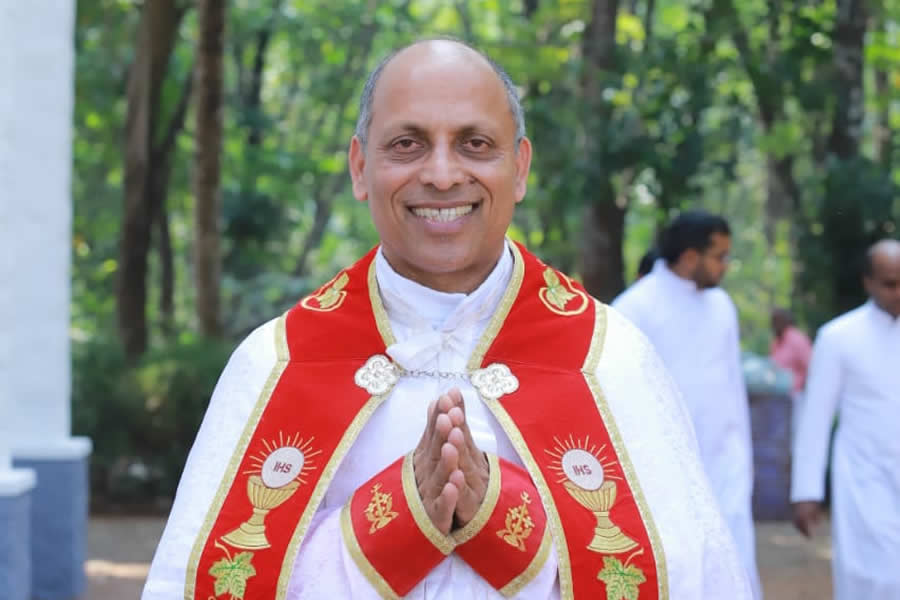
Syro-Malabar Church - Eastern Catholic Church
05-29-2022Weekly ReflectionRev. Fr. Jacob Thomas Vettathu, MSThe Syro-Malabar Church is an Eastern Catholic church based in Kerala, India. The Syro-Malabar Church is an autonomous (sui iuris) particular church in full communion with the pope and the worldwide Catholic Church, including the Latin Church and the 22 other Eastern Catholic Churches, with self-governance under the Code of Canons of the Eastern Churches (CCEO). The Church is headed by the Major Archbishop Mar George Cardinal Alencherry. The Syro-Malabar Synod of Bishops canonically convoked and presided over by the Major Archbishop constitutes the supreme authority of the Church.
Syro-Malabar is a prefix coined from the words Syriac as the church employs the East Syriac Rite liturgy, and Malabar which is the historical name for modern Kerala. The name has been in usage in official Vatican documents since the nineteenth century. It is the second largest Eastern Catholic Church in the Catholic communion, after the Ukrainian Greek Catholic Church. The Syro-Malabar Church is primarily based in India; with 5 metropolitan archeparchies (archdioceses) and 10 suffragan eparchies in Kerala, there are 17 eparchies in other parts of India, and 4 eparchies outside India. The Syro-Malabar Church is the largest of the Thomas Christian denominations and the third largest sui juris Church in the Catholic communion, with a population of 4.25 million worldwide as estimated in the Annuario Pontificio 2016.
The Church traces its origins to the evangelistic activity of Thomas the Apostle in the 1st century. The earliest recorded organized Christian presence in India dates to the 4th century, when Persian missionaries of the East Syriac Rite tradition, members of what later became the Church of the East, established themselves in modern-day Kerala and Sri Lanka. The Syro-Malabar Church employs an Indianised variant of the Liturgy of Saints Addai and Mari belonging to the historic Church of the East, which dates back to 3rd century Edessa, Upper Mesopotamia. As such it is a part of Syriac Christianity by liturgy and heritage.
After the schism of 1552, a faction of the Church of the East came in communion with the Holy See of Rome (Chaldean Catholic Church) and the Church of the East collapsed due to internal struggles. Throughout the later half of the 16th century, the Malabar Church was under Chaldean Catholic jurisdiction. Mar Abraham of Angamaly was among the last of Chaldean bishops. He was the Metropolitan of Angamaly (1568-1597) and given the title of "Metropolitan and Gate of all India".
Through the Synod of Diamper of 1599, the Malabar Church was subjected directly under the authority of the Latin Catholic Padroado Archbishopric of Goa and the Jesuits. After a half-century administration under the Goa Archdiocese, dissidents held the Coonan Cross Oath in 1653 as a protest. In response, Pope Alexander VII, with the help of Discalced Carmelite friars, by 1662, was able to reunite the majority of the dissidents with the Catholic Church. After over two centuries under the Latin Church's hegemony, in 1887, Pope Leo XIII fully separated the Syro-Malabarians from the Latin Church (the Archdiocese of Verapoly remained as the jurisdiction for Latin Catholics). Leo XIII established two Apostolic Vicariates for Syro-Malabarians, Thrissur and Changanassery (originally named Kottayam), and in 1896, the Vicariate of Ernakulam was erected as well, under the guidance of indigenous Syro-Malabar bishops.
In 1923, the Syro-Malabar hierarchy was organized and unified with Ernakulam as the Metropolitan See The Syro-Malabar Church in effect became an autonomous sui iuris Eastern church within the Catholic communion. Catholicism within the Syro-Malabar Church is unique in that it has inculturated with traditional Hindu customs through its Thomas Christian heritage. Scholar and theologian Placid Podipara describes the community as "Hindu in Culture, Christian in Religion, and Oriental in Worship."[ 36]
The Church is predominantly of the Malayali ethnic group who speak Malayalam, although there are a minority of Tamils, Telugus, and North Indians from the various eparchies outside Kerala. Following emigration of its members, eparchies have opened in other parts of India and in other countries to serve the diaspora living in the Western world. There are four eparchies outside of India, concentrated in English-speaking countries such as Australia, Canada, UK, and US.
Saint Alphonsa is the Church's first canonized saint, followed by Saint Kuriakose Chavara, Saint Euphrasia, and Saint Mariam Thresia. It is one of the two Eastern Catholic churches in India, the other one being the Syro-Malankara Catholic Church which represents the faction of the Puthenkoor that returned to full communion with the Holy See of Rome in 1930. https://en.wikipedia.org/wiki/Syro-Malabar_Church
To have a taste of Syro Malabar Mass and Liturgy, we have one church in Phoenix:
Holy Family Syro Malabar Catholic Church
3221 N 24th St
Phoenix, AZ 85016
(623) 328-5784